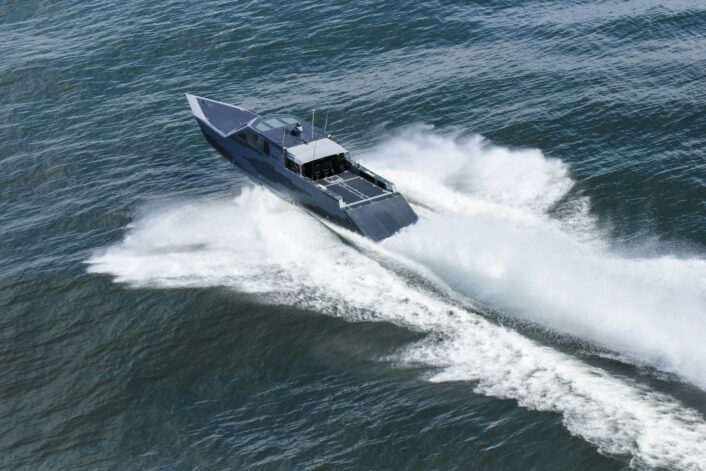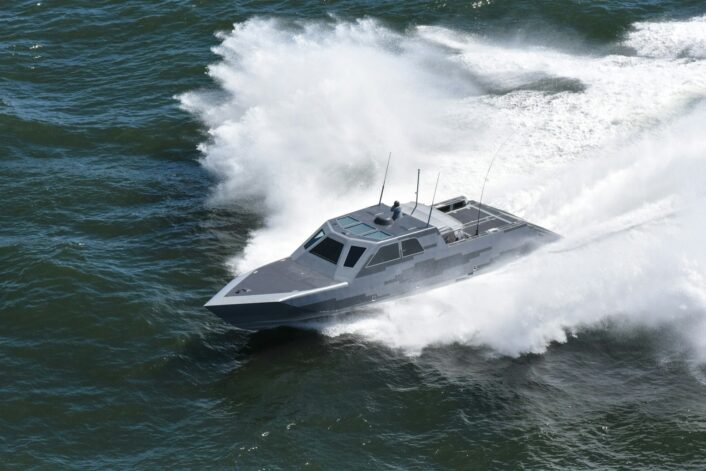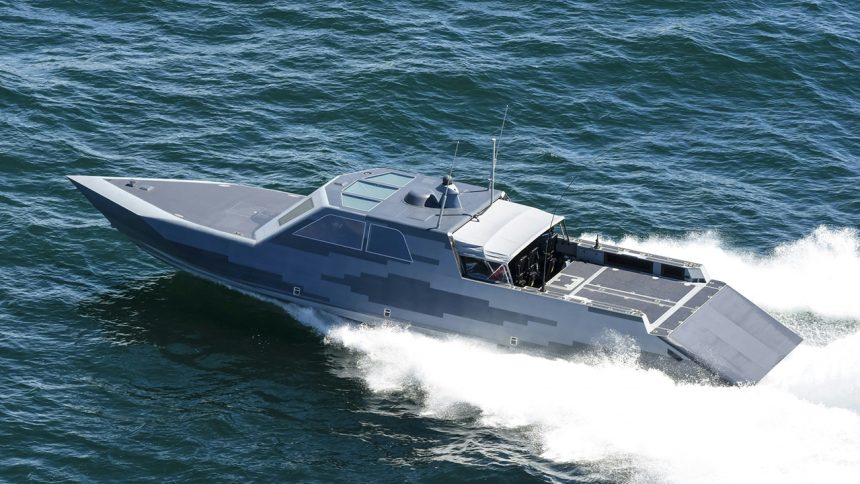The Special Operations Forces (SOF) Week conference displayed a graphic illustration of the launcher, showing a multi-pod system with eight or more pods available.
US special operations planners want to find a way for their Combat Craft Medium (CCM) boats, used to “insert and extract Navy SEALs,” to release loitering munitions, beside other combat-support payload.
The CCM is a 60-foot-long boat with a top speed of 52 knots, operated by a crew of four with space for 19 more passengers and a total load of 4,535-kg. It has a cruising range of 600-nautical miles. The CCM patrol boat, made by shipbuilder Vigor Industrial, was first commissioned in 2015 to replace the rigid hull inflatable boat.

Loitering Munitions & Drone Launching Module
The last four years have seen the Special Operations Command working on being able to install a launcher kit to the CCM. The pod should be able to release “standoff, loitering, man-in-the-loop weapons system” that can target “individuals, groups, vehicles and small, oceangoing craft,” according to program materials quoted by Defense News. The ongoing Special Operations Forces (SOF) Week saw officials commenting on the requirements and the future of the CCM program.
Special Warfare Combatant Crewmen fm Special Boat Team 12 aboard a #CCM Combat Craft Medium recover a #Kingfish Mk18 Mod2 #UUV unmanned underwater vehicle during exercises in Guam 18 Nov. The Kingfish performs sonar hydrographic surveys, is able to locate objects including mines pic.twitter.com/Hg17oNa1ma
— Chris Cavas (@CavasShips) November 23, 2020
While the payloads mentioned are the lethal core combat devices, the launcher must also carry combat support equipment like “surveillance drones, electromagnetic warfare pods or sensor packages for a variety of missions,” according to Commander Marty Burns, program manager for maritime surface systems.
The Special Operations Forces (SOF) Week conference displayed a graphic illustration of the launcher, showing a multi-pod system with eight or more pods available to house both ordnance and combat support equipment. According to officials at the SOF Week, final testing and a live fire of the launcher module are planned by late-2024 or early-2025.
Combatant Craft Medium (CCM) Special Boat Team 20 of the Naval Special Warfare fleet in Chesapeake City, Maryland on the C&D Canal – April 8, 2024
SRC: FB- Baltimore & Chesapeake Bay Ship Watchers pic.twitter.com/B8ZEZQdonl
— WarshipCam (@WarshipCam) April 8, 2024
Once the testing phase concludes and the government-owned design kit is approved for installation, the command’s fleet of 31 CCMs will be progressively sent for the modification, keeping a part of the inventory operationally available at all times. The Original Equipment Manufacturer (OEM) of the CCM, Vigor International, will likely have a role to play in the installation and hull modification.
US Navy’s Captain Jared Wyrick, SOCOM program executive officer for maritime, said that the command is also working on building a boat replacement, called the CCM Mk2.

A primary tactical consideration being taken into account before installing munitions launching pods to the CCM is reducing heat signatures, is to avoid detection by adversary infrared sensors. The US Navy has an option of choosing the Switchblade series of loitering munitions, that are propeller-driven and are released through a tube. Whether they pick the drones, or any other series of operationally active loitering munitions made by a US ally, remains to be seen.
Tactical Scenarios
But the need for an armed CCM is interesting, given that the SOCOM still sees tactical and strategic relevance for sea-borne special operations insertions on enemy shores and littoral areas. With the US might shifting eastwards towards the Pacific for a confrontation with China, such boats could come in handy while landing operators on islands controlled by friendly nations like the Philippines or Japan.
If the war escalates, continues longer and the US is forced to bring in greater military might while having made tactical gains and bringing the fight closer to Chinese islands, the munitions payloads could be used to ‘soften’ defensive structures on the islands before the CCM disembarks operators. The SEAL operators would most likely be in diving gear, entering the water far from the shore.
Tactics, training and procedures could be developed to release the reconnaissance drones for optical surveillance and electronic support equipment for gauging the nature of jamming and electromagnetic interference in heavy electronic warfare (EW) and contested environments.
While the design of the launcher module is not known, it ideally should be able to carry a mix of one-way attack and pure reconnaissance UAVs, since any special ops mission for manned destruction of high-value shore targets will require both these capabilities.









